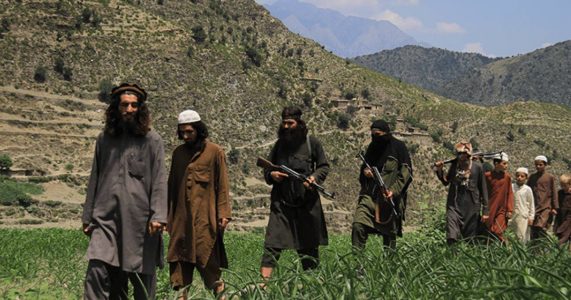
Islamic State activity intensifies in Afghanistan as the U.S. forces begin to implement the exit strategy
The Afghan affiliate of ISIL, known as the Islamic State Khorasan (ISIS-K) fired five rockets at the Bagram airfield in Afghanistan early on April 9. No casualties or injuries occurred according to Resolute Support – the NATO-led mission stationed at the U.S. base.
The attack comes several weeks after the United States and its NATO allies announced they will begin withdrawing troops from the region over a 14-month period in exchange for security guarantees from the Taliban.
The agreement marks a significant turning point on the country’s road to peace after an 18-year deployment of U.S. led forces in the region. However, neither ISIS-K, the group who claimed responsibility for Thursday’s attack, or any other Islamic State militants were included in the pact, suggesting the road to peace will be a rocky one. ISIS insurgents are responsible for some of the deadliest attacks in Afghanistan’s urban centers in recent years and have killed thousands of civilians and security personnel since they first arrived in Afghanistan in 2014.
ISIS-K said in a statement on social media that their fighters had targeted a helicopter landing pad at the base. An Afghan security official in Parwan Province where Bagram is located, confirmed this account telling RFE/RL that the rockets were fired from a Toyota, Corona in an adjacent village shortly before 6A.M.. A few weeks earlier the same ISIS affiliate claimed responsibility for an attack at a Sikh religious complex that killed 25 people according to a report by AL Jazeera.
The escalation of violence by Islamic State and their affiliates in Afghanistan confirmed fears of U.S. Defense Secretary, Mark Esper, who following the signing of the speech deal told the BBC that, “This is a hopeful moment, but it is only the beginning. The road ahead will not be easy. Achieving lasting peace in Afghanistan will require patience and compromise among all parties.”
Last Thursday’s incident marks the fourth attack targeted at Bagram, the largest U.S. airfield in Afghanistan since the Trump Administration first introduced the possibility of reaching a diplomatic solution with the Taliban in early February. The final agreement was signed on February 29 by U.S. special envoy Zalmay Khalilzad, and Taliban political chief Mullah Abdul Ghani Baradar, with U.S. Secretary of State Mike Pompeo, as a witness in Doha, Qatar.
In a speech, Mr. Pompeo urged the militant group to “keep your promises to cut ties with al-Qaeda”.
The recent upsurge of violence from the Islamic State illuminates a shortcoming of peacemaking efforts that refuse to incorporate all hostile actors into peacemaking negotiations. Similar outcomes occurred after the 2008 U.S. troop withdrawal from Iraq which created a power vacuum in the region allowing ISIL forces to gain momentum before eventually invading Syria, in 2011. Foreign Affairs explains this hasty withdrawal initiated one of the largest humanitarian crises the world has seen since World War II. Human Rights Watch reports more than 400,000 have died as a result of the Syrian conflict since 2011, with at least 5 million seeking refuge abroad and over 6 million displaced internally, according to UN agencies. As the U.S. moves forward with troop removal in Afghanistan, there is a significant possibility that the territory is vulnerable to a similar trajectory due to the already destabilized situation in which multiple non-state actors are competing for power.
ISIS-K fighters, who battle foreign and Afghan government forces, as well as the Taliban, have strongholds in Nangarhar and Kunar, provinces near the Afghanistan-Pakistan border. They also operate in Laghman, Jowzjan provinces with pockets of support throughout Afghanistan according to reporting by CIA Factbook. They recruit from the local populations, Central Asian extremists in Afghanistan, and other militant groups, such as Tehrik-e Taliban Pakistan, the Afghan Taliban, and the Islamic Movement of Uzbekistan. Al Jazeera says that as of now the U.S. government is reporting that ISIS-K has about 2,000 active fighters, however, the Afgan government suggests the numbers are much higher.
U.S. military engagement in Afghanistan began in 2001, after the September 11 attacks on the World Trade Center, in New York City. At the time the Taliban had central control of the Afgan government and refused to hand over Osama Bin Laden, the then Al-Qaeda leader charged with orchestrating the September 11 attack. The Taliban was quickly removed from power in a joint effort between U.S. and NATO forces however the militant group continued its effort to destabilize subsequent Afghan governments for the next decade and a half.
The international NATO coalition ended its combat mission with the Taliban 2014, staying only to train Afghan forces to defend themselves. Meanwhile, the U.S. continued its own, scaled-back combat operation, including airstrikes which will now come to an end if the Taliban agrees to hold up their end of the deal. In addition to the ceasefire, the Taliban must cooperate with a prisoner exchange program negotiated by the Afghan government that would see some 5,000 Taliban prisoners released in exchange for 1,000 Afghan security force prisoners held hostage by the Taliban. The first day of the prisoner swap began Wednesday, April 8 one day before the most recent assault on Bagram. At this time it is still unclear if the two events are related.
Source: The OWP





